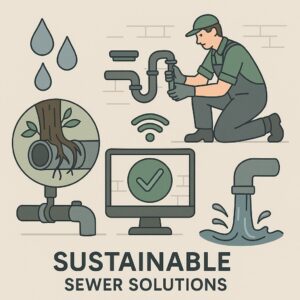Key Takeaways
- Understanding the importance of sustainable plumbing practices.
- Identifying common sewer issues and their eco-friendly solutions.
- Insight into innovative technologies in the plumbing industry.
- Importance of regular maintenance for long-term sewer health.
Introduction
The escalating demand for urban sewer systems has made adopting sustainable plumbing practices more critical. As metropolitan areas expand, the pressure on existing infrastructure mounts, necessitating an approach that resolves immediate issues and ensures long-term viability. Among the most effective strategies is working with a sewer drain plumber adept at integrating sustainable solutions in routine maintenance and repairs. This combination of expertise and eco-friendly methodology is crucial in meeting the demands of modern urban life without compromising environmental health.

Incorporating sustainability in plumbing tackles practical inconveniences and aligns with broader environmental goals. With solutions prioritizing ecological balance, homeowners and businesses can achieve optimal sewer system functioning while reducing environmental impact. Understanding the available strategies and their benefits can empower individuals to make informed decisions supporting immediate and future environmental health.
The Need for Sustainable Plumbing
The surge in urban populations and the corresponding increase in waste production underscore the necessity for sustainable plumbing. While effective in the short term, traditional plumbing techniques often fail to account for environmental impacts, leading to resource depletion and habitat disruption. Embracing sustainable practices, such as water-saving fixtures and energy-efficient systems, can significantly reduce these negative impacts. According to a scientific study on sustainable buildings, green plumbing systems contribute to reducing emissions and conserving resources, playing a vital role in urban environmental management. Implementing these systems requires a forward-thinking approach, ensuring that growth does not come at the environment’s expense.
Common Sewer Problems
Sewer systems, especially in older urban areas, frequently encounter blockages, leaks, and tree root intrusions. These issues interrupt everyday life and may cause considerable environmental harm if not promptly addressed. Obstructions, often resulting from incorrect waste management, can cause backflows and spills, presenting health hazards and necessitating substantial repairs. Leaks, conversely, may remain undetected for long durations, wasting water and leading to structural harm. Tree roots are well-known for pursuing moisture, often breaching and harming sewer lines, leading to expensive and complicated repairs. Recognizing these common issues is the first step in developing practical and environmentally friendly solutions.
Eco-Friendly Solutions to Sewer Issues
The transition towards eco-friendly solutions is a vital response to the growing environmental awareness and regulatory pressures. Techniques such as trenchless technology exemplify how repairs can be conducted with minimal environmental disruption. This approach removes the requirement for significant digging, maintains natural scenery, and lowers waste. Natural enzyme treatments offer another sustainable solution, breaking down organic waste and preventing costly blockages without resorting to harsh chemicals. The Environmental Protection Agency (EPA) provides comprehensive guidelines on minimizing the ecological impacts of plumbing repairs, emphasizing sustainable practices in reducing waste and conserving resources. These approaches restore functionality and align with a commitment to protect the environment.
Innovative Technologies Making a Difference
Technological advancements are transforming the plumbing industry, making it more efficient and environmentally friendly. Innovative sewer systems, for example, utilize sensors and data analysis to continuously monitor sewer lines’ health and functionality. This technology facilitates timely interventions, preventing minor issues from escalating into major problems. Materials such as recycled plastics and piping are also being adopted to minimize resource consumption. By integrating these innovations, the plumbing industry can improve service delivery, reduce maintenance costs, and significantly reduce environmental footprints. The proactive use of technology ensures the sustainable management of sewer systems, promoting long-term health and functionality.
Benefits of Regular Maintenance
Regular maintenance is crucial in preserving the integrity of sewer systems and preventing emergencies. Scheduled inspections and cleanings help identify potential issues before they cause significant damage, saving time, resources, and money in the long run. Maintenance also extends the life of plumbing infrastructure, ensuring it operates optimally. By committing to regular upkeep, property owners not only enhance the functionality of their systems but also contribute to broader environmental sustainability goals by reducing the need for resource-intensive repairs and replacements. This proactive approach aligns with sustainable principles, fostering long-term financial and ecological benefits.
Final Thoughts
Adopting sustainable solutions for sewer problems is an essential strategy for modern urban living. Leveraging innovative technologies and committing to regular maintenance practices can significantly enhance the functionality and longevity of plumbing systems while reducing their environmental footprint. This holistic approach, while initially requiring investment, promises significant returns in terms of ecological preservation and cost efficiencies. As individuals and communities recognize the importance of sustainable practices, they can take meaningful steps toward a healthier, more resilient future.





